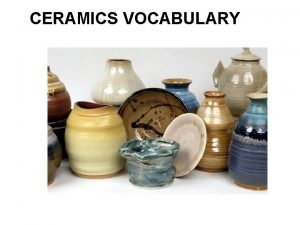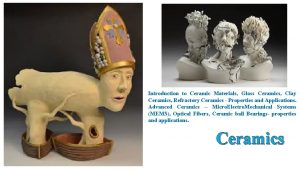GLAZING Ceramics Ceramic glaze is a layer of













- Slides: 13

GLAZING Ceramics

Ceramic glaze is a layer of a vitreous (glasslike) substance which has been fused to a a ceramic piece through firing. Glaze can color, decorate or waterproof an item. Glazing renders your work suitable for holding liquids. It also gives a tougher/stronger surface. The glaze ingredients will melt together when fired to form a glossy glass-like surface. GLAZE IS…

FIRING is the process of heating ceramic work in the kiln to bring the clay or glaze to maturity. During Firing, the clay goes through 2 processes – dehydration and vitrification. Dehydration is when the water leaves the clay Vitrification is the fusing of particles – and after this, clay can never return to its original plastic state Our bisque firing goes to CONE 06 – (about 1800 degrees) Our glazes fire to CONE 5 – (about 2200 degrees) More on CONES, firing and temps later… FIRING

CONES

The purpose of a glaze is to: ◦ 1. Decorate or add color to a ceramic piece. ◦ 2. Waterproof a ceramic object. A clay body should be glazed in order to seal and make it water-tight. ◦ 3 – Plan glaze colors to add to the overall appearance of your work, not detract from it. Glazing is generally done by brushing, pouring, dipping or spraying. GLAZE

Many different colors are possible using minerals and elements as a basis for colorant. The color of the liquid glaze IS NOT necessarily the color it will be when fired. (Check glaze test tiles for an idea of glaze color) When firing, the objects should be placed about ¼” apart and from the sides of the kiln to prevent the two surfaces from bonding together.


GLAZING RULES There rules that need to be followed to help us be successful.

** Glaze is expensive, glaze only those works you plan to keep. 1. Rinse off your bisque pieces to remove any oxidation, dust or clay particles. (Glaze will not stick to loose foreign matter. ) ◦ Defects from glazing: Blistering, pinholes, crawling, running, cracks and dull sheen to name a few. 2. Remove rough spots before glazing with sandpaper. (No sanding of pots inside classroom. Go outside if sanding is necessary. ) RULES FOR GLAZING

3. Mix glaze – particles settle to the bottom when not in use. Be especially careful not to contaminate one glaze with another. (Clean glaze mixer before and after each mixing. ) 4. Wipe off bucket lids and replace them on glaze containers immediately after using. (Make sure you put the correct lid on the correct glaze container! ) RULES FOR GLAZING

5. After glazing your pieces, clean up drips on tables and floor. Clean brushes and tongs if used and return to glaze area. 6. CLEAN WORK - Clean off any glaze that sticks to the foot of the ceramic piece. You can use wax resist – if you do, clean up any glaze that beads on top of the resist. Bottoms of pots and about 1/8” 1/4” up the side of piece (dryfoot) must be absolutely free of glaze or the pot will not be fired. 7. Put cleaned glaze work in storage container – table on the right to be fired. RULES FOR GLAZING

Often, a piece can be PAINTED with acrylic paints. There are many more choices of colors when using paints. If you paint a piece, it should be for decorative purposes only… Painted pieces are NOT meant for use with food and can’t hold liquids. ADVICE

CAUSES OF DEFECTS BLISTERS AND PINHOLES: ◦ Caused by bisque not being rinsed before glazing. Glaze trapped in the pours of the clay. CRAWLING OR SCALY SURFACE: ◦ Dust or oil on the clay surface. RUNNING GLAZE: ◦ Glaze was applied too heavily. CRACKS IN THE GLAZE: ◦ Glaze applied too heavily – the glaze will pull apart at the cracks when fired. POOR SURFACE OR DULL SHEEN: ◦ Glaze applied too thin.
 Ceramic glaze before and after
Ceramic glaze before and after Metodo de jones blount y glaze
Metodo de jones blount y glaze Magneglaze
Magneglaze Pseudolistening definition
Pseudolistening definition Layer 2 vs layer 3 bitstream
Layer 2 vs layer 3 bitstream Secure socket layer and transport layer security
Secure socket layer and transport layer security Secure socket layer and transport layer security
Secure socket layer and transport layer security Layer 6 presentation layer
Layer 6 presentation layer Layer 2 e layer 3
Layer 2 e layer 3 Fig 19
Fig 19 Secure socket layer and transport layer security
Secure socket layer and transport layer security Layer-by-layer assembly
Layer-by-layer assembly How are glands classified
How are glands classified Secure socket layer and transport layer security
Secure socket layer and transport layer security

























